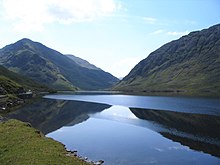Doolough Tragedy

The Doolough Tragedy is an event that took place during the Great Irish Famine close to Doo Lough in southwest County Mayo.[1]
Events[]
On Friday 30 March 1849, two officials of the Westport Poor Law Union arrived in Louisburgh to inspect those people in receipt of outdoor relief to verify that they should continue to receive it.[2] The inspection, for some reason, did not take place and the two officials went on to Delphi Lodge – a hunting lodge – 19 kilometres (12 miles) south of Louisburgh where they intended to spend the night. Several hundred people who had gathered for the inspection, or later did so, were consequently instructed to appear at Delphi Lodge at 7am the following morning if they wished to continue receiving relief.[3][4] For much of the night and day that followed seemingly hundreds of destitute and starving people had to undertake what for them, given their existing state of debilitation, was an extremely fatiguing journey, in very bad weather.[2][5]
A letter-writer to The Mayo Constitution newspaper reported shortly afterwards that the bodies of seven people, including women and children, were subsequently discovered on the roadside between Delphi and Louisburgh overlooking the shores of Doolough lake and that nine more never reached their homes.[6] While some sources put the total number of deaths at approximately 20 people, local sources suggest that the number who perished was far higher.[4]

A cross and an annual 'Famine Walk' between Louisburgh and Doolough commemorates this event.[7] The monument in Doolough valley has an inscription from Mahatma Gandhi: "How can men feel themselves honoured by the humiliation of their fellow beings?"[2]
References[]
- ^ Horgan, Gertrude M. (1967). Tales of the West of Ireland. Dufour Editions. p. 39. Retrieved 10 February 2012.
- ^ Jump up to: a b c Miles, Alice (7 May 2009). "The Black Lake's Secret". New Statesman. Retrieved 10 February 2012.
- ^ "Doolough Valley Famine Walk and the National Famine Memorial". mayo.ie. Mayo County Council. Retrieved 9 March 2021.
- ^ Jump up to: a b "Famine Walk 2009" (PDF). afri.ie. Afri. 2009. Retrieved 9 March 2021.
- ^ "RTÉ Archives - Fáilte Go Féile Dhubhlocha (1991)". rte.ie. RTÉ. 1991. Retrieved 9 March 2021.
- ^ "Doolough" (PDF). The Famine in Mayo 1845-1850. Mayo Library. p. 7. Archived from the original (PDF) on 10 June 2011.
- ^ "Annual Famine walk held in Mayo". irishtimes.com. The Irish Times. 23 May 2011. Retrieved 10 February 2012.
- Great Famine (Ireland)
- 1849 in Ireland
- Poor Law in Britain and Ireland